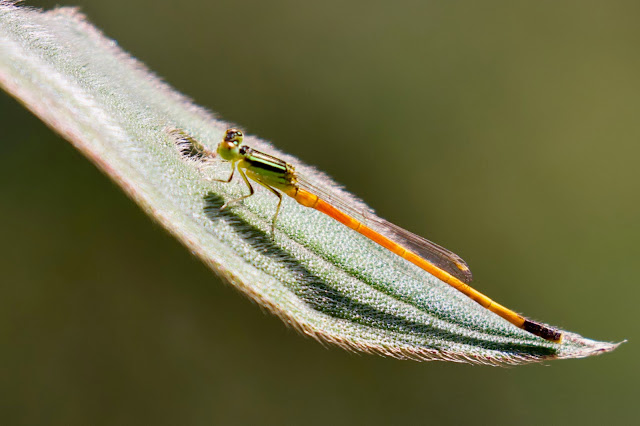Family Coenagrionidae
Ischnura forcipata
Morton, 1907
Elevation 500 - 1800m
Abdomen length 22-23mm
This is a fairly common wetland and streamside species that appear early in the season - April and May. It was found in the pond near the Godavari khunda along with I. r. rufostigma and P. decorum. It is also found downstream from the Iceberg Beer factory in Godavari where water quality is poor. The thorax is grass green, contrasting with the black surface of the abdomen with blue on segments 8, 9, and sides 10. Segment 10 is variable some have blue oval spots some have a small patch of blue. The blue postocular spots are small but easily seen on the backs of black eyes, as well as a tiny pale blue spot on the pterostigma in the fore wing. Appearing early in the spring mating twice at the beginning (April) and end of the season (September). I have photographed two female forms, red and pale blueish green. They are a Himalayan species from Afghanistan to Northeast India.
Male
Selys 1876
Elevation of sea level to 1800mm
Abdomen length 16-20mm
Male
Female
Mating
Ischnura rufostigma rufostigma
Selys 1876 (rufostigma group)
I. annandalei Laidlaw 1919; I. mildredae Fraser 1926; I. carpentieri Fraser (1946) Asahina (1970) placed I. carpentieri and I. annandalei in synonymy with I. mildredae and considered all to be a subspecies of I. rufostigma
Elevation 700 - 1600m
Abdomen Length 23-24mm
Elevation 700 - 1600m
Abdomen Length 23-24mm
At first glance, it is very similar to I. aurora but the amount of blue in segment 8 varies. There are many variations of blue and even no blue. Vick 1986, worked on the I. rufostigma group because of the many noticeable variations of the abdominal segments 6-10 and what he considered distinct differences in male anal appendages.
This one is from Godavari. Vick 1986, placed it in the carpentieri group with a blue mark on the 8th segment and stronger tubercles. Asahina (1991) later described these under the name I. rufostigma montana, because of the elevation where it was found - ie Godavari Nepal. The group remains confusing and without molecular work, the confusion will not be resolved. A 2016 paper from China attempted to sort out the I. rufostigma group and the biomorphic coloration found in the females. They found that the phenotypic variability in the expression of color was related to allele configuration and not different species.
Females in the photos show two color forms as per the taxon the pterostigma is bicolored. Mating was observed twice in June and September. They are found at the Kunda on the water and in the grasses. Seen from March through October.
Male
Ischnura rufostigma rufostigma
Selys 1876 (rufostigma group)
Elevation 700 - 1600m
Abdomen Length 23-24mm
This one is the sub-species found in Pokhara (it is different from the Godavari form above) found along the edge of Phewa Taal, Dipang, and Rupa Taal. It has no blue on the 8th segment. The bichromatic females can be found in red and the androchrome form of the male. They are found from March through the end of September. The I. rufostigma group is widely distributed and there are many differences within the group, but all are lumped under rufostigma. It has been divided into several subspecies but still, the amount of work on this one is inconclusive. Vick 1986 divided them into two groups one from Pokhara as I. rufostigma rufostigma and from Kathmandu (Vick) as I rufostigma carpentieri but then Asahina 1991 changed that to I.rufostigma montana and then just forma.
Male

Female
Ischnura nursei
(Morton, 1907)
Elevation 80m plains
Abdomen length 14mm
Its common name is Pixie Dartlet. The thorax is black on the dorsum and pale blue sides, and the abdomen is a mix of red and black with pale reddish anal appendages. It is found in grassy areas around lakes and wetlands in India. In Nepal, it is found at Jagadispur Lake near Lumbini. A paper on this sighting was published by Milan Aryal in 2019. The photo below is courtesy of Milan Aryal. A tiny but quite pretty species.
Male
















No comments:
Post a Comment